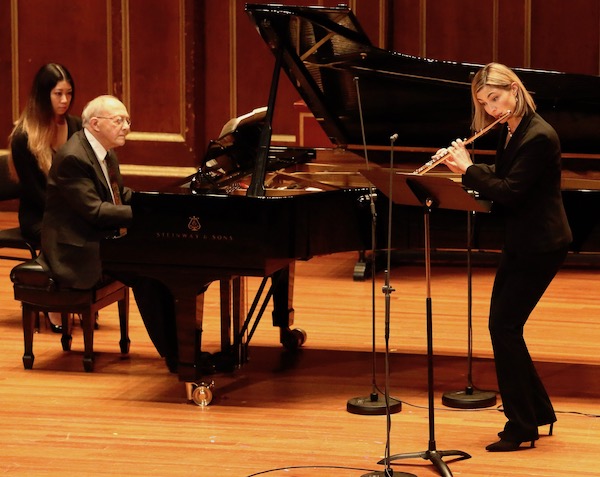Boston Symphony Chamber Players celebrate John Harbison in style

Elizabeth Rowe and Gilbert Kalish performed John Harbison’s Duo Sunday afternoon at Jordan Hall. Photo: Hilary Scott
John Harbison’s music remains an enigma for some listeners. Though his music often casts an eye towards tradition, his overall style is elusive, each new composition differing from the last, often significantly.
So when the Boston Symphony Chamber Players offered four of his chamber works at Jordan Hall Sunday afternoon in celebration of the composer’s recent 80th birthday, one was left with the impression that Harbison constantly pushed at his own limitations to find fresh forms for his rich musical imagination.
His Duo for flute and piano dates from 1961, and its five brief movements reflect a vibrant neoclassicism that likely resulted from his studies with Walter Piston at Harvard.
On Sunday, flutist Elizabeth Rowe and pianist Gilbert Kalish made the most of Harbison’s long, spiraling lines. The two musicians lingered in the opening movement, where each phrase evolved organically from a four-note motive. In the second movement, Rowe and Kalish painted a musical scene cast in bright and velvety tones. The energetic, trickling melodies of the third movement complemented the fourth, a melancholy dithyramb that was by turns sweet and declamatory. The finale had the simple elegance and sly wit of a Satie sonatina.
In his Wind Quintet of 1979, Harbison explored all the colors made possible by a well-balanced wind ensemble. But unlike the Duo, the melodic writing here is terse. Wide, angular melodies ease into ear-tingling chords that could be at home in one of Schoenberg’s orchestral sores. In the early movements, motives dart, uncoil in nervous statements, and slip in and out of distantly related keys. Jazz creeps into the final movements, where the lines churn like bebop riffs before flaring into a uniform shriek.
In the Chamber Players’ hands, the vibrant shades that Harbison paints in this score shifted in unexpected ways. Jagged statements erupted from placid harmonies in the Intrada. The short strains of the Intermezzo, traded between flutist Rowe, clarinetist William R. Hudgins, and bassoonist Richard Svoboda, bounded, and the passages of the Romanza coalesced into glistening, Debussyian sonorities. The musicians handled the Scherzo and Finale with the verve of a Dixieland band.
Harbison’s Piano Quintet of 1981 featured the composer trying on different stylistic hats. Though bristling with dissonance, this five-movement masterpiece of modern chamber literature has an occasional Brahmsian melodic sweep. Elsewhere, sharp Bartókian rhythms fall like hammer strokes, and the final movement is tinged with a sarcasm reminiscent of Shostakovich’s music.
Unfortunately, the Chamber Players’ performance failed to effectively contrast the darkness and light, especially in the quick movements. The pulsing rhythms of the Capriccio and Burletta felt soupy, lacking zest and requisite edge. The slow movements fared better, with the dense chords of the Intermezzo and Elegia, a musical memorial to Harbison’s sister, echoing with dusky resonance. At the piano, Kalish proved a sensitive presence throughout.
Deep Dances for cello and double bass, written for a choreographed performance by the Rebecca Rice Dance company in 2006, is a tuneful delight. Realized by cellist Blaise Déjardin and bassist Edwin Barker, Harbison’s music lumbered, surged, and broke into free-flowing cadenzas. The highlight was the final movement, a galumphing waltz that evaporated into silence.
No composer has had quite the effect upon Harbison’s musical development like J.S. Bach, whose music Harbison has performed and conducted since his youth. Sunday’s performance of Bach’s Cantata No. 51, Jauchzet Gott in allen Landen, proved a spirited tribute to both musical masters.
The vocal soloist was soprano Amanda Forsythe, one of the most elegant interpreters of Baroque repertoire on the scene today. Cantata No. 51 is operatic in style, and Forsythe sang each solo section with radiant warmth. She unspooled long melismas in the opening aria and her high notes in “Wir beten zu dem Tempel an” blossomed from soft attacks. Her singing of “Höchster, mache deine Güte” had the reverence of a personal prayer.
Trumpeter Thomas Rolfs brought clarion tone and idiomatic finesse to his fanfares and trills in the opening Aria and concluding “Alleluia.” Cellist Déjardin provided supple continuo support while harpsichordist Kalish managed Bach’s ever-spinning accompaniment with all the grace he could muster, given that he had to hold his music on the stand with his right hand for much of the performance. Violinists Haldan Martinson and Alexander Velinzon joined violist Steven Ansell to make Bach’s accompaniment flower beautifully.
The Boston Symphony Chamber Players will perform music by Rossini, Gandolfi, Barber, and the world premiere of a new work by Elena Langer 3 pm. March 3 at Jordan Hall. bso.org; 888-266-1200
Posted in Performances




